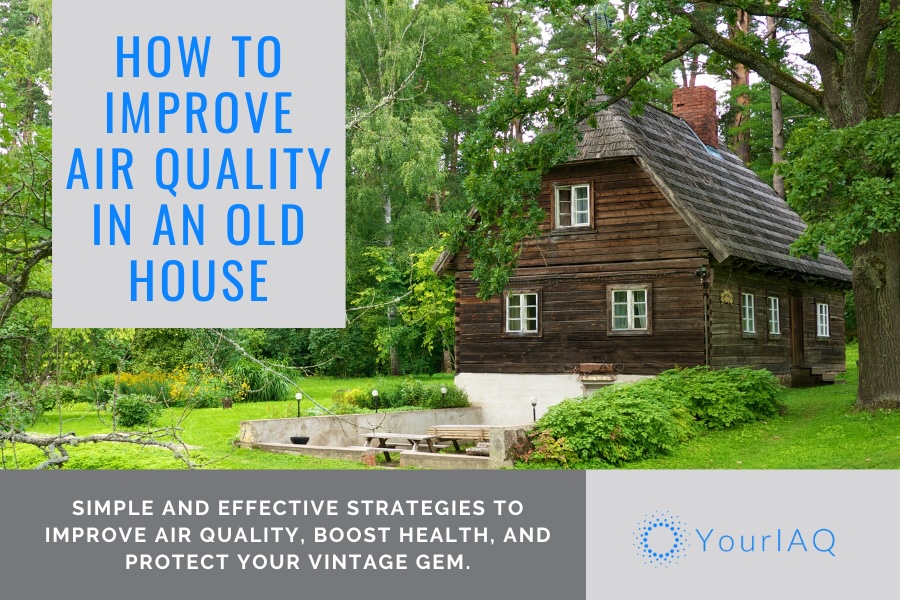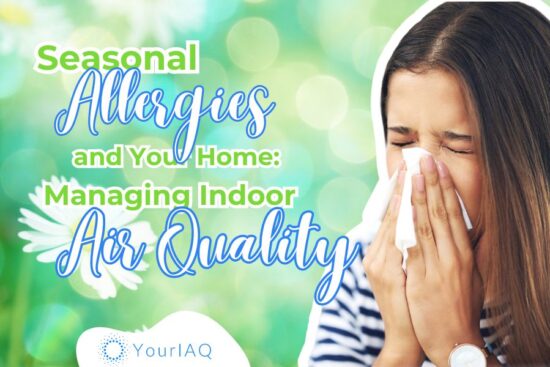
Living in an old house holds a certain magic, right? From the creaky floorboards whispering stories of the past, the sun dancing through stained glass to the cozy nooks begging for a good book and a steaming mug. But along with the vintage charm often comes a not-so-charming guest: less-than-stellar indoor air quality.
Fear not, fellow history lovers! Before you start daydreaming about new construction (and a hefty mortgage), know this: improving air quality in an old house is totally doable, and the benefits are worth their weight in gold (or maybe vintage brass, in this case).
How to Improve Air Quality in an Old House
We spend a whopping 90% of our time indoors, which makes the air we breathe inside twice as important as the crisp autumn breeze outside. Good indoor air quality isn’t just about avoiding stuffy noses and allergy attacks. It’s about boosting your health, lowering your healthcare costs, enhancing your productivity, and even reducing the long-term costs of maintaining your beloved old home.
Think about it: healthy lungs don’t require as many doctor visits, a sharper mind leads to better career opportunities, and preventing moisture build-up saves you from costly repairs down the line. It’s all connected, folks!
Now, let’s get down to the nitty-gritty of how to improve air quality in your old house:
1. Seal the Cracks and Save Resources
Old houses, for all their charm, can be notorious for their air leaks. These insidious gaps around windows, doors, and attics act as silent entry points for a host of unwanted guests: chilly drafts, dust, pollen, and even moisture. Studies by the United States Department of Energy (DOE) show that air leaks can account for up to 30% of a home’s energy loss, significantly impacting your heating and cooling bills.
But fear not, homeowners! By plugging these leaks, you’re not just banishing drafts and reducing your energy bill; you’re also putting yourself in better position to control your indoor environment. Research suggests that sealing air leaks in older homes can lead to a significant decrease in the indoor presence of particulate matter, improving air quality and potentially reducing allergy symptoms.
So, grab your trusty caulk and weatherstripping and get strategic! Focus on key areas like
- Windows and doors: Pay special attention to gaps around frames and weatherstripping. Replacing worn seals and applying caulk to cracks can make a significant difference.
- Attics and basements: Seal any openings to crawl spaces and around ventilation pipes. Consider adding insulation around attics to prevent heat loss and air infiltration.
- Fireplace flues: When not in use, ensure dampers are properly sealed to prevent cold air from seeping in.
By investing a little time and effort in sealing air leaks, you’ll be rewarded with a warmer, healthier, and more energy-efficient home. It’s a win-win for your comfort, your wallet, and your indoor air quality. Every tiny crack you seal is a giant leap towards a healthier haven in your cherished old house.
2. Ensure Proper Ventilation
It’s important to remember that while sealing air leaks from outside can prevent intrusion of external pollution, it can also trap chemicals and contaminants inside. Think of your house as a living organism – it needs to breathe, too!
Proper ventilation ensures fresh air circulates, flushing out stale air and those pesky indoor pollutants. Research conducted by the Environmental Protection Agency (EPA) highlights the crucial role of ventilation in maintaining healthy indoor air quality. Their studies reveal that indoor air is two to five times more polluted than outdoor air, harboring dust mites, allergens, and even chemicals from building materials.
Proper ventilation dilutes these contaminants, creating a healthier environment for you and your family. Open windows whenever possible, especially during mild weather. Nature’s ventilation system is free and effective, flushing out stale air and welcoming fresh breezes.
But what about winter, you ask? Consider the following options:
- Exhaust Fans: These battle moisture and pollutants in high-humidity areas like bathrooms and kitchens. Installing and regularly using exhaust fans significantly reduces airborne contaminants and prevents mold growth.
- Whole-House Ventilation Systems: They ensure continuous air exchange throughout your home, constantly pumping out stale air and bringing in fresh. Popular options include mechanical ventilation systems and natural ventilation systems, both offering effective solutions for consistent air quality.
- Heat Recovery Ventilators: HRVs are innovative heroes that go the extra mile. They exchange air while recovering heat from outgoing air, maximizing energy efficiency and keeping your home warm and healthy.
Don’t forget about nature’s own air purifiers — house plants. Studies from NASA prove certain plants like Spider Plants and Peace Lilies effectively filter pollutants such as benzene and formaldehyde, adding a touch of greenery and fresh air to your home.
3. Regularly Clean the House
Dust mites and their allergen-laden dander love old houses like cats love yarn. To keep these microscopic menaces at bay, regular cleaning is your best friend. Vacuum diligently (with a HEPA filter!), wash bedding and curtains frequently and consider using allergen-proof covers for mattresses and pillows. The American Academy of Allergy, Asthma & Immunology highlights the effectiveness of allergen-proof mattress and pillow covers, creating a physical barrier preventing dust mites and their allergens from escaping into the environment.
Bonus tip: Consider replacing wall-to-wall carpets with hard floors, like wood, tile, or laminate, as they have smooth surfaces that offer less real estate for dust mites to cling to, making cleaning a breeze.
However, carpets offer benefits like insulation and noise reduction. If you prefer the comfort and warmth of carpets, opt for low-pile options that trap less dust and allergens. Regular cleaning with a HEPA filter vacuum is crucial to keep dust mites and their dander at bay. Whether you go with hardwoods or carpet, do your product research and choose a flooring option without VOCs or with limited off-gasing.
4. Monitor the Humidity Level
High humidity is a recipe for mold and mildew growth, both of which wreak havoc on your air quality and your respiratory system. Invest in a good hygrometer to monitor your home’s humidity levels, and aim for a range between 30% and 50%. Dehumidifiers will become your new best friends in damp basements or bathrooms, while regular kitchen and bathroom ventilation also helps keep moisture in check.
Things to keep in mind: Keep an eye on potential leaks! Faulty plumbing, damaged roofs, and even improper insulation contribute to excess moisture.
5. Check the Materials Used
Old houses often hold hidden nasties like lead paint and asbestos. While disturbing them shouldn’t be your first move, being aware of their potential presence is crucial.
If you suspect these materials might be lurking, consult a professional for proper assessment and removal. When it comes to renovations or new furniture, opt for low-VOC (volatile organic compound) materials to minimize indoor air pollution.
You can find low-VOC labels in several places depending on the product and manufacturer:
1. Product packaging: Look for the label directly on the product packaging, often near the barcode or ingredients list. Common labels include:
- GREENGUARD Certified: Indicates low chemical emissions and meets strict indoor air quality standards.
- UL GREENGUARD Gold Certified: A more stringent version of GREENGUARD, suitable for sensitive individuals and schools.
- SCS Indoor Advantage Gold: Another rigorous certification program for low-emitting materials.
- California Air Resources Board (CARB) compliant: Meets low-VOC emission standards set by the state of California.
- VOC content listed numerically: Some products may simply list the VOC content in grams per liter (g/L). Aim for products with VOC levels below 50 g/L for healthier choices.
2. Manufacturer websites: Many manufacturers list their low-VOC products and certifications on their websites. They also offer downloadable product information sheets that often include details about VOC content.
3. Building supply stores: Ask store staff about their selection of low-VOC materials. They might have dedicated sections or product listings highlighting low-VOC options.
4. Sustainability certifications: Products with broader sustainability certifications, like Cradle to Cradle or LEED, often include low-VOC materials as part of their criteria. Look for logos or information about these certifications on packaging or product descriptions.
Bonus tip: Utilize online resources like GreenSpec or the Environmental Building Products (EBP) database to search for specific low-VOC products by category and compare options.
6. Build Your Indoor Air-cleaning Arsenal
Experiment with different solutions, monitor the changes and adjust your approach as needed. Here are some additional weapons in your arsenal:
- Air Purifiers: Consider investing in an air purifier equipped with a HEPA filter, especially if you’re prone to allergies or live in a polluted area. Studies conducted by the National Institute of Environmental Health Sciences (NIEHS) show that HEPA filters remove up to 99.97% of airborne particles as small as 0.3 microns, significantly improving indoor air quality and reducing allergy symptoms. Choose an air purifier with a CADR (Clean Air Delivery Rate) rating appropriate for your room size for optimal effectiveness.
- Regular Pet Grooming: Don’t neglect your furry friends in the air quality crusade! Regular pet grooming, especially for breeds with thick fur, significantly reduces airborne pet dander, a common allergen. Furthermore, keeping pet areas clean and well-ventilated minimizes the impact of hair and odor on your indoor air quality.
The Takeaway
Living in an old house doesn’t have to mean compromising your health and well-being. By applying these simple strategies, you can transform your vintage haven into a sanctuary of clean air and good health. You’ll be breathing easier, saving money, and preserving the charm of your old home for generations to come.
Improving air quality isn’t just about your house; it’s about creating a healthier, happier you. And that’s something worth celebrating.
Frequently Asked Questions
Should I open windows even in winter?
Yes! Brief bursts of fresh air help flush out stale air and pollutants. Just layer up and enjoy the invigorating winter breeze.
What air purifier should I buy?
Choose a purifier with a CADR rating appropriate for the square footage of your room. Higher CADR ratings indicate better air cleaning performance in larger spaces. Look for an excellent CADR rating for large rooms, HEPA filter, and air ionizer.
Are low-VOC materials more expensive?
Within the low-VOC range, there are varying levels of eco-friendliness and performance. Generally, higher-performing, VOC-free, or natural material-based options are pricier than basic low-VOC products.
How can I test my home’s humidity?
Invest in a hygrometer! This handy tool accurately measures your home’s humidity levels, allowing you to maintain that ideal range between 30% and 50%. For even more guidance, check out the EPA’s handy indoor humidity guide.
Is upgrading my ventilation worth it?
Investing in proper ventilation, like exhaust fans or HRVs (heat recovery ventilators), significantly improves air quality and energy efficiency. Consult a qualified HVAC professional for options specific to your house’s needs and layout. They can help you find the most effective and cost-efficient ventilation solutions for your vintage haven.







